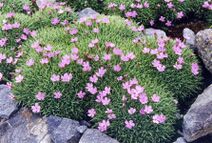Dianthus anatolicus
| Dianthus anatolicus | |
 | |
| Light: | |
| Moisture: | |
| Hardiness: | 6 |
| Soil pH: | 6.6-8.4 |
| Self Pollinated | |
| Height: | 1' |
| Width: | 2' |
| Blooms: | Mid Summer-Late Summer |
| Native to: | |
| Shelter | |
| Medicinal Rating: | |
| Tea: | Yes |
Dianthus anatolicus
Propagation: Seed - sow spring in a cold frame[1]. The seed usually germinates in 2 - 4 weeks at 20°c. When they are large enough to handle, prick the seedlings out into individual pots and grow them on in the greenhouse for at least their first winter. Plant them out into their permanent positions in late spring or early summer, after the last expected frosts.
Cuttings in July/August in a cold frame. Very high percentage.
Division in March[1]. Larger clumps can be replanted direct into their permanent positions, though it is best to pot up smaller clumps and grow them on in a cold frame until they are rooting well. Plant them out in the spring.
Cultivation: Prefers an alkaline soil though it can also thrive in neutral and slightly acid soils down to a pH of 6[2]. Requires sunny position[2].
Range: W. Asia - Turkey to E.. Asia - western Tibet.
Habitat: Found at elevations of 2,400 - 3,000 metres in the Himalayas.
Medicinal: The plant is used as an antiperiodic in the treatment of intermittent fevers[3].
Pollinators: Bees, lepidoptera
Soil: Can grow in light, medium, and heavy soils.
Drainage: Prefers well drained soil.
Flower Type: Hermaphrodite
Links
References
- ↑ 1.0 1.1 Sanders, Thomas. Popular Hardy Perennials. Collingridge, 1926.
- ↑ 2.0 2.1 Huxley, Anthony. The New Royal Horticultural Society Dictionary of Gardening. MacMillan Press, 1992.
- ↑ Chopra, R. Glossary of Indian Medicinal Plants. Council of Scientific and Industrial Research, New Delhi, 1986.